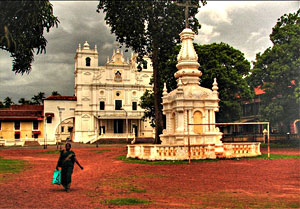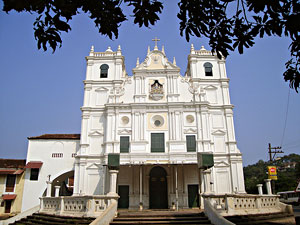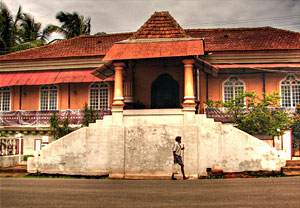|
|
Margao
(Madgaon), Goa
..........................................................................................
|
|
Information about Margao
Margao (also known as Madgaon) is the capital of the
southern taluka of Salcette which is the state’s richest
and most fertile and also of the South Goa district.
Margao is the main population centre of south Goa and is
probably the busiest town in the state. Margao is Goa's
second largest town and a bustling commercial centre. It
is a pleasant provincial town, which was given the
status of twon by Royal decree in 1778. In fact, the
name Margao is |
 |
|
|
thought to be
the Portuguese corruption of the word Mathgram (from Math - a
Hindu religious centre that used to exist there). However most
of these were destroyed when the Portuguese absorbed the area
into their Novas Conquistas during the 17th century. Because
of its location, it serves as a service and transport hub to
the areas of south Goa. It is a typically crowded Goan town,
with chaotic, noisy traffic and quite a few architectural
reminders of its Portuguese past. Surrounded by fertile
farmland, the town of Margao was once a major religious
centre, with dozens of wealthy temples and dharmshalas
(dormitories). Margao has an old-worldly charm about it
because of its Portuguese churches, and some magnificent
specimens of old Portuguese houses complete with shady balcaos
(porches) and oyster-shell windows in its Borda area.
Market in Margao
The town of Margao has an excellent market area stretching
from the south edge of the main square to within a stone's
throw of the old railway station. The Bazaar centres on a
labyrinthine covered area that's a rich source of authentic
souvenirs and a good place to browse for some bargain
shopping. Margao's fish market was earlier located opposite
the Municipal building and was a spectacular sight, with the
fisherwomen from coastal areas of South Goa hawking their
wares at the top of their voices, dressed in superbly coloured
cotton sarees. The market has since been shifted to a complex
located at the entrance of the city.
Tourist Attractions in Margao
The main tourist attraction in Margao are its markets - the
covered market in the town's centre is one of the largest and
most raucous in Goa and there is a fish and produce market in
a vast complex near the Kadamba bus stand. The richly
decorated Church of the Holy Spirit is worth a look and can be
positively exciting when a big service is taking place. |
|
|
|
Church of the Holy Spirit
The Largo de Igreja, or the Church of the Holy Spirit as
it is also known, dominates the entrance to the city,
just north of the Municipal Garden square. The church
area is surrounded by beautiful old residential houses
still in pristine condition. The church was originally
constructed in 1564 over the ruins of a Hindu temple, it
was sacked by Muslim in 1589 and completely rebuilt by
the Portuguese in 1675. The church is one of the finest
examples of late-Baroque |
 |
|
|
architecture
in Goa, boasting a pristine white façade and an interior
dripping with gilt crystal and stucco. In the square is a
monumental cross with a mango tree beside it.
House of Seven Gables
Just within walking distance of the Church, is the famous
"House of Seven Gables" or "Sat Burzam Ghor". This magnificent
mansion was commissioned in 1790 by Sebastino da Silva,
emissary and private secretary of the Portuguese Viceroy.
Although only three of the seven gables remain today, they are
enough to give the visitor an idea of the size of the original
edifice.
Colva Beach
The famous Colva beach is just 6 kms away from Margao, so most
travellers coming to this area of Goa, tend to spend their
time in the beach area, rather than enjoy the charms of Margao
town itself.
Chandor
The lush village of Chandor, 15 km east of Margao, is one of
the best respites from the beach in south Goa. Here, more than
anywhere else in the state, the opulent lifestyle of Goa’s
former Portuguese overlords is visible in a couple of decaying
colonial mansions. Braganza House takes up one whole side of
Chandor village square and dates back to the 17th century.
It’s now divided into east and west wings, which stretch
outward from a common front entrance. Ongoing restoration is
slowly taking place and the ballrooms have Italian marble
floors, Belgian glass chandeliers and carved rosewood
furniture. The east wing is owned by the Pereira-Branganza
family, and includes a small family chapel containing a
carefully hidden fingernail of St. Francis Xavier. The old
family photos, cheap souvenirs from friends abroad and tacky
knick-knacks all add to an overall sense of melancholy. The
west wing, belonging to the Menezes - Braganza family, had
invested money in its restoration and is crammed with
beautiful furniture and a whole museum's worth of Chinese
porcelain. The two large rooms behind the entrance halls
contain the largest private library in Goa. The elderly and
formidable Mrs Menezes Braganza lives here alone and, once
she's waved her maids aside. In general there appears to be a
lack of concern about these old houses and without urgently
needed funds for their restoration, you can only wonder what
will become of them once the current custodians are gone. Both
homes are open daily, but you may want to call ahead to ensure
the owners will be around. There is no official entry fee, but
the owners rely on contributions for maintenance and
restoration. |
|
|
|
Ancestral Goa
Ancestral Goa is dedicated towards the preservation of
art, culture and enviroment and inorder to preserve
Goa's past and its rich traditions. This magnificent
project is the result of a lot of meticulous research,
planning and hardwork. It was opened to the public in
April 1995. Ancestral Goa is miniature Goan Village as
it would have existed 100 years ago. It is located in a
area of nine acre on a hill at Loutulim in
|
 |
|
|
South Goa,
about 10 kms from Margao. Graceful swans charm the entrance to
the reception. Elephants carrying flowered pillars with
multi-hued and decorated beams deck the entryway. A spacious
room of the Goan - Portuguese era completes with a palanquin,
sepia-toned photographs, domed lamps and a designed marble
floor. The traditional 'aarti' is performed as part of the
greeted welcome by a sari-clad goan girl. Lord Parashuram, an
incarnation of Lord Vishnu, shot the legendary arrow into the
bosom of the Indian Ocean which resulted in the emotive
paradise known as Goa. The visitor is treated to a sight of
Parashuram at the entrance itself, all ready with the
proverbial bow & arrow. One step out of the high- ceilinged
entrance, sporting a "punkah" and one moves into a landscape
spread over a gently rolling hill where laterite steps lead to
"Demo" (the caretaker of the landlord's property). The
Ancestral Goa project, the brainchild of Goan artist, Maendra
J. Alvares who has used his family's ancestral property to
keep Goa's culture alive and is a place worth visiting as any
lay visitor can get a glimpse of Goa in its original grandeur
and authentic form. This place also gives visitors a glance of
a sight other than beaches, churches and temples which Goa is
famous for and imparts a culture based education about the
roots and heritage of Goa. Local feasts and festivals are
celebrated with traditional style and fervour. A visit to
Ancestral Goa on any of the feast days, allows to experience
the Goan customs and lifestyles. The Eat-out offers a menu
full of traditional Goan Specialties. Local vegetables, fish
and sweets are treats to be indulged in. Some of the sights
inside Ancestral Goa are Art Gallery and Handicraft Center,
Mirabai Sculpture, Big Foot Dance Floor, Casa da Dona Maria,
Anand Lotlikar's Ghor, Legend of Big Foot, The Farmer's House,
Cross, Spring and Rakandar, the Fisherman's House, Escola da
Musica, Bhati - the feni distillery, Tinto - the village
market, Taverna - the country liquor shop, Goan Artisans, Bird
Habitat, Spice Yard and Rubber Plantation.
Fernandes House
A kilometre past the church is the Fernandes House. It is
smaller and less grand than the Braganza House, but older and
with an interesting history. The original India house here
dates back more than 500 years, while the Portuguese section
was tacked on by the Fernandes family in 1821. The secret
basement hideaway, full of gun holes and with an escape tunnel
to the river, was used by the family to flee attackers.
Quepem
South of Chandor, in the village of Quepem, the immaculately
renovated Palacio do Deao has recently opened to visitors. The
beautiful gardens are as much an attraction as the 200 year
old mansion.
Loutolim
Further relics of a bygone age can be found in the unhurried
village of Loutolim, 10 kms. northeast of Margao. There are a
number of impressive Portuguese mansions here but the only one
officially open to the public is the 250-year-old Casa Arajao
Alvarez though it lacks much of the atmosphere of the houses
of Chandor. It’s also possible to visit the wonderful
Figueiredo House. This house, and its sister owners, were
memorably featured in William Dalrymple’s brilliant book, The
Age of Kali, where, over tea and mango juice, Mrs Dona
Georgina Figueiredo gets all uppity about the ‘botheration’
that was the Indian ‘invasion’ of Goa in 1961. It’s
fascinating reading and a visit to this house makes for an
interesting hour or so. It’s also possible to stay in one of
the dark rooms. Anywhere else such a room would be overpriced
but here the experience is worth every rupee. Traditional Goan
meals are also available if you book in advance. Also in the
village, and set up purely for tourists, Ancestral Goa is a
re-creation of Goan village life under the Portuguese a
century ago.
How to reach Margao
By Rail:
Margao's new Train station, Madgaon, the only stop in Goa for
quite a few long distance express services on the Konkan
Railway, is about 3 kms southeast of the town centre.
By Road:
Local private buses to Colva and surrounding villages make
stops at various places inside the town. Long distance buses
to Panaji, Vasco and destinations outside Goa, stop and leave
from the main Kadamba Bus Stand, 3 km away on the outskirts of
the town. Loutolim is best visited by motorcycle or taxi from
Margao. |
|